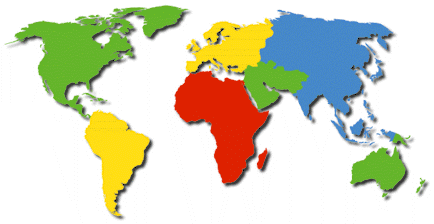
Hawai‘i Creole
written by Ermile Hargrove,
Kent Sakoda and Jeff Siegel

This page includes information on:
Listen
to Hawai‘i Creole.
BACKGROUND History
Hawai'i was first visited by Europeans in 1778, and it quickly became an important stopover for ships involved in whaling and trading with Asia. At this time, some of the expressions from the Pidgin English of China and the Pacific were introduced to Hawai'i. Tragically, diseases were also introduced which drastically decreased the indigenous Hawaiian population. The first sugarcane plantation was established in 1835, and the industry expanded rapidly in the last quarter of the century. Thousands of laborers were brought from China, Portugal, Japan, Korea, Puerto Rico, Russia, Spain, the Philippines and other countries. With so many nationalities, a common language was needed on the plantations. At first, this was Hawaiian and Pidgin Hawaiian, but later in the century a new variety of pidgin began to develop.
In the 1870s immigrant families began to arrive and more children were born on the plantations. Children learned their parents' languages and picked up English at school. But the kind of English they spoke on the playground was influenced by the Pidgin English earlier brought to Hawai'i, by the Hawaiian spoken by their parents, and by their own first languages, especially Portuguese. By the turn of the century a new Hawai‘i Pidgin English began to emerge with features from all of these sources. This pidgin became the primary language of many of those who grew up in Hawai'i, and children began to acquire it as their first language. This was the beginning of Hawai'i Creole English. By the 1920s it was the language of the majority of Hawai'i's population.
Attitudes and use
Hawai'i Creole (or Hawai‘i Creole English) is usually called "Pidgin" in Hawai'i. It has a rich linguistic history based on the need for a common language among a diverse group of people who spoke different languages. It also has a dark side based on plantation domination and American English hegemony.
Hawai‘i Creole speakers have mixed feelings about the creole. Hawai‘i Creole has often been denigrated as a sub-standard form of English. But with the efforts of local linguists and writers, people are now beginning to realize that the creole is a language separate from, but similar in appearance to, English.
Hawai‘i Creole can be heard on the playgrounds and in neighborhood conversations. It can also be heard on a few radio programs and in some advertising. On rare occasions, Hawai‘i Creole is heard in more formalized situations, such as on the legislative floor and in the classroom. However, English and Hawaiian are the official languages of the legislature and standardized English is the official medium of instruction in the school system.
See the position paper "Pidgin and Education" written by "Da Pidgin Coup", a group of interested faculty memebers and students at the University of Hawai'i.
BACK TO TOP SOUNDS GRAMMAR
VOCABULARY
Since English is the lexifier language of Hawai‘i Creole, most of the words come from English. But they are often pronounced in a different way (see Sounds), and some may have different meanings. For example: beef can mean 'fight'. Also, some combinations of words have different meanings: e.g. stink eye means 'dirty look' and chicken skin means 'goose bumps'.
Hawai‘i Creole also includes words from many other languages, especially Hawaiian. Here are some examples:
word
meaning
from Hawaiian:
pau
lanai
puka
akamai
okole
pilau
'finished'
'verandah'
'hole'
'clever'
'buttocks'
'filthy'from Japanese:
obake
shi-shi
'ghost'
'urinate'from Portuguese:
malasada
'doughnut without a hole'
SOUNDS
Like other creoles, Hawai‘i Creole has its own individual system of sounds. Although most of its consonants are similar to those found in varieties of British and American English, the vowels are quite different. Here we talk only about the differences.
(Note: Hawai‘i Creole has its own spelling system. The examples here are given in that system and then in English-based spelling.)
Consonants
In words that come from English, many speakers of Hawai‘i Creole say 't' or 'd' instead of the 'th' sounds &endash; for example, tink 'think' and dis 'this'.
For many speakers, the 't' sound is usually pronounced as 'ch' before 'r', as in chri (chree) 'tree; and the 'd' sound is pronounced as pronounced as 'j' before 'r', as in jril 'drill' Also, especially in fast speech, the 's' sound is pronounced as 'sh' before 'r' or 'tr', as in groshri 'grocery' and shchrit (shtreet) 'street'.
The 'r' is not pronounced after some vowels -- for example: paking 'parking' (pronounced like 'pahking') , sked 'scared' and fo 'for'. Sometimes, the final 'r' is changed to another vowel, as in dia 'dear' and welfea 'welfare'. This "r-less" feature is also found in the English spoken in Australia, parts of England, and in the northeastern USA (where the early missionaries to Hawai'i came from).
Vowels
For most speakers of Hawai‘i Creole the 'ee' sound in 'keen' and the 'i' sound in 'kit' are pronounced similarly, somewhere in between the way the two sounds are pronounced in most varieties of British and American English. The sound of the 'u' in 'put' or 'oo' in 'good' is pronounced similarly to the sound of the 'u' or in 'rule' or 'oo' in 'pool'.
Also, Hawai‘i Creole has what are sometimes called "pure" vowels, as found in languages such as Spanish and Hawaiian, whereas English vowels are typically stretched and changed somewhat. For example, the Hawaiian name Kekoa is usually pronounced as 'Kay-koh-wa' by English speakers.
Intonation
One of the most striking characteristics of Hawai‘i Creole is in the intonation pattern or "melody" you can hear when people speak. One difference between Hawai‘i Creole and varieties of English is in the intonation of questions that can be answered "yes" or "no". In most varieties of American English, for example, the pattern is rising, ending at higher pitch or tone of voice. But in Hawai‘i Creole, the pattern is falling, dropping to lower pitch in the last syllable.
In addition, some Hawai‘i Creole words which come from English differ slightly in pronunciation because a different syllable is emphasized most, or stressed. In these examples, the stressed syllable is shown in capital letters: dikshaNEri 'dictionary', haraKEIN 'hurricane', aelkaHOL 'alcohol'.
BACK TO TOP BACKGROUND VOCABULARY
As noted above, Hawai‘i Creole has its own spelling system. The examples here are given in that system and then in English-based spelling.1. Basic sentences
Sentences giving a location use the word ste (stay):
Da kaet ste in da haus. 'The cat's in the house.'
(Da cat stay in da house.)The word get is used for 'there is/are':
Get tu mach turis naudeiz. 'There are too many tourists nowadays.'
(Get too much tourist nowadays.)Haed (had) is used for 'there was/were':
Haed dis ol grin haus. 'There was this old green house.'
(Had dis old green house.)Like in many other languages, no verb is required in some sentences:
Nau yu da hed maen. 'Now you're the head man.'
(Now you da head man.)Mai sista skini. 'My sister's skinny.'
(My sister skinny.)2. Tense and aspect
The verb is usually used without endings, but there are words that come before the verb
which show when or how something happens. These are called "tense/aspect markers".Past tense is commonly indicated by using wen before the verb.
Dey wen pein hiz skin. 'They painted his skin.'
(Dey wen paint his skin.)Future events and those that have not yet occurred are marked by go, gon, or gona:
Yu gon trn in yaw pepa leit? 'Are you going to turn in your paper late?'
(You gon turn in your paper late?).Events in progress may be indicated in three different ways: by ste (stay) before the verb
either with or without the -ing ending, or just by the verb with -ing:Da kaet ste it da fish.
(Da cat stay eat da fish.)Da kaet ste iting da fish.
(Da cat stay eating da fish.)Da kaet iting da fish.
(Da cat eating da fish.)All of these mean: 'The cat's eating the fish.'
The verb by itself (without a tense/aspect marker or ending) is used for talking about things
that happen all the time or about something that the listeners already know happened in
the past (for example, in a story someone is telling):Da kaet it fish. 'The cat eats fish.'
(Da cat eat fish.)3. Negatives
Hawai‘i Creole has four ways of making negatives. First, nat (not) is inserted when there is no verb:
Nau yu nat da hed maen. 'Now you're not the head man…'
(Now you not da head man.)Mai sista nat skini. 'My sister isn't skinny.'
(My sister not skinny.)Second, no is used before ste, before modals such as kaen (can) and before verbs
without any ending and without any tense/aspect markers:Da kaet no stei in da haus. 'The cat isn't in the house.'
(Da cat no stay in da house.)Jo no kaen plei. 'Joe can't play.'
(Joe no can play.)Da kaet no it fish. 'The cat doesn't eat fish.'
(Da cat no eat fish.)Third, neva (never) is used before verbs in past tense negatives:
Ai neva du om. 'I didn't do it.'
(I never do em.)(Note that om (em) is used for 'him, her. it' after verbs.)
Finally, nomo (no more) is used for 'there isn't/aren't':
Nomo kaukau in da haus. 'There isn't any food in the house.'
(No more kaukau in da house.)4. Verbal complements
Verbal complements are other verbal expressions that come after the main verb, such as
in George decided to join the army. In Hawai‘i Creole, these are introduced by fo rather than to:Ai chrai fo kaech om. 'I tried to catch it.'
(I try fo catch em.)Eribadi kam fo si daet haus. 'Everybody comes to see that house.'
(Everybody come fo see dat house.)
BACK TO TOP VOCABULARY SOUNDS
If you can use Java Script, you can test your knowledge of Hawai‘i Creole grammar by trying a short quiz. |
|

